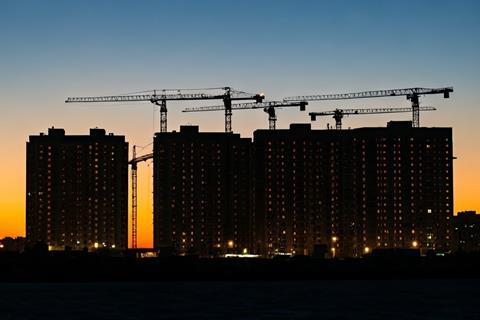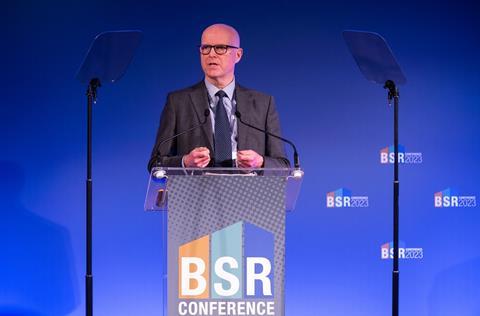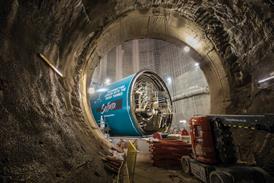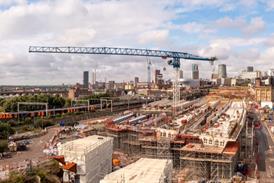As the government attempts to ramp up housing construction, the new system of gateway checks on high rise buildings is adding anything up to 18 months to construction programmes. Joey Gardiner speaks to the regulator and industry experts to find out why

Last month student housing giant Unite broke cover about what is now one of the biggest issues facing developers of high-rise residential buildings in England. In a trading update, the firm revealed that delays caused by the “new approval gateways” policed by the new building safety regulator (BSR) were forcing it to add “around six months” to project timelines.
Unite is by no means alone. David O’Leary, executive director for policy at the Home Builders’ Federation, says some of the industry group’s members have reported waits of a year or more for approval. In the construction industry, of course, time is money, and there is mounting frustration across the sector over an issue that some say is having a profound impact on the development of high-rise resi schemes.
“This is huge,” says O’Leary. “It’s right up there with the biggest issues the industry is facing.”
>> Also read: Reeves promises not to renege on building safety regulation as 90 new high-rise projects are held up by rules
>> Also read: The ����Ӱ�� Safety Act is changing project procurement. Here’s how to navigate the way ahead
The delays relate to the new regime for high-rise residential buildings over 18 metres (HRBs) under the 2022 ����Ӱ�� Safety Act. The legislation stipulates that remediation or new-build HRB schemes must seek approval from the BSR at three separate “gateway” points: planning approval; prior to construction; and prior to occupation.
The process is designed to provide security that the project has been fully designed prior to construction with its safety case properly thought through. However, the commencement of gateway 2 and gateway 3 checks is causing a significant hiatus as the regulator appears to be unable to deliver decisions within the promised timeframe.
Under the ����Ӱ�� Safety Act, developers cannot get on site with construction until gateway 2 is passed. Industry experts say that delays at this crucial stage are making projects more costly and harder to get off the ground, just when the government is saying that it wants to turbo-charge housebuilding to deliver 1.5 million homes in five years.
So, how bad is the problem? And what are the chances it can improve?
Huge uncertainty
The ����Ӱ�� Safety Regulator came into being in April 2023. The gateway 2 and 3 checks came into force from October that year, albeit under transitional arrangements, many “in flight” projects were in practice able to escape the requirement to submit schemes until 6 April, 2024. In advance of setting up, the regulations committed the BSR to turn around decisions at gateway 2 on remediation projects within eight weeks, and new-build schemes within 12 weeks.

However, the regulator began on the back foot, with the person leading the set-up, Peter Baker, resigning in April 2023 within days of its launch. Then, last summer, the collapse of a large private approved inspector, AIS, unexpectedly landed an additional 50 in-flight projects on the team.
The picture of its performance from parliamentary questions and freedom of information requests (FOIs) is concerning. Last September, Rushanara Ali, a junior government minister, that, by the end of June, only 2% of the 668 applications submitted had been determined in the promised timeframe, with 40% of applications refused.
>> Also read: Peter Baker: Meet the man who must ensure no repeat of Grenfell
According to various industry-submitted questions under the Freedom of Information (FOI) Act showing the picture up to September, only around 145 out of just over 1,000 projects had by then managed to secure approval at gateway 2. The FOI data obtained by the Construction Products Association found that a third of all applications submitted to date were then “under review” waiting for determination.
These numbers fit with the anecdotal picture. Chris Martin, a director at London-based consultant Martin Arnold, which is involved both in new-build and recladding schemes, says one scheme has been in for over 30 weeks at gateway 2 without an outcome. “Developers are also telling us they have had projects rejected with very little feedback, and then you have to go to the back of the queue,” he says. “There’s just no confidence about the outcome.”
Delays experienced so far have, for the most part, happened before companies have even got to the final test point, gateway 3, which must be passed prior to occupation. Gateway 3 happens at the moment of maximum financial strain on a project, when all the outlay has been made, potentially stretching out the point at which developers can start generating income to pay back their investors and lenders.
Damien Sharkey, MD at London-based resi developer Hub, says the development programme is also lengthened because the gateway 2 approval requires the full building design to be much further advanced pre-construction. This already adds “months” to the programme before the application is in.
Once in, he says it is now taking between 25 and 40 weeks currently to get decisions back at gateway 2, according to his consultant teams. From then he is making the assumption – few in the market have done it so far – that it may take another two to four months to get an approval at gateway 3 prior to occupation.
“You factor in all three of those things and that adds something like 12 to 18 months to the development programme,” he says. “It is huge uncertainty and really challenging.”
Andrew Moore, head of operations, planning and building control at the BSR, admits that the organisation is “certainly not there yet” on meeting the timeframes to process applications. “We haven’t met target times yet, the time that we’re taking to assess is coming down, but we’re not at the statutory SLAs [promised service level agreement timeframes] yet.”
For some firms this is an existential challenge given the additional finance costs involved
David O’Leary, executive director for policy at the Home Builders’ Federation
As evidence that some progress is being made, Moore provided data on the 186 decisions taken by the BSR since October last year, of which 57 (31%) were rejected. He said approvals were taken in an average of 22 weeks, with rejections happening significantly faster (17 weeks).
He also refutes the idea that applications have been rejected without feedback, saying all applicants are given both a face-to-face meeting and a follow-up very detailed point-by-point letter explaining the reasons why applications have failed. “I really push back on the idea we’re not providing that detail. We’re being really clear,” Moores says.
Existential challenge
Nevertheless, the delays for new-build work are being exacerbated by the fact that the regulator – for understandable reasons – has been prioritising remediation projects above new-build work.
The HBF’s O’Leary says the issue is making developers think twice about bringing projects forward. “It’s having a huge impact on anyone that works in the high-rise space,” he says. “For some firms this is an existential challenge given the additional finance costs involved. The real problem is just the unknowns.”
Martin, of Martin Arnold, says the issue is affecting whether schemes were viable, and forcing promoters to make some schemes taller in a bid to recoup additional costs incurred from the lengthening build programmes.
Hub’s Sharkey agrees. “We’re having to factor in huge contingencies with our investors’ money, and this is affecting viability. Now we’re having to underwrite delay and the risk it might get refused,” he says. “And gateway 3 is a huge financial strain when viability is already really challenged.”
The issue is also affecting contractor procurement, according to Natalie Taylor, senior associate at law firm Blake Morgan. Rather than go straight into a design and build contract, she says many developers are choosing to bring in contractors under flexible pre-construction services contracts until gateway 2 has been passed, because of fears about being hit with extension of time claims.
Taylor says most developers are at that point choosing to secure design and build contractors – despite continuing uncertainty over who bears the risk of further delays at the gateway 3 stage.
“When do you sign a building contract, and who takes the cost risk? It’s just not clear,” says Sharkey, who is gloomy about the wider implications of all this for housebuilding. “We need to urgently reform this or things are going to grind to a halt, and we’ll have no chance of meeting housing targets.”
Delivery model
So, what is causing the problem? Moore admits there were teething problems setting up the BSR. “We’re new, so we’ve been getting our processes and procedures sorted,” he says. “At the beginning that was the main cause of delays – it was us getting to grips with being a new regulator.”
Graham Watts, chief executive of the Construction Industry Council, says he has been attending a weekly Monday morning meeting for the past six months convened by Philip White, director of the BSR, designed to track and tackle the issues, with senior industry figures in attendance. While he defends many of the actions of the BSR, he admits: “It’s true the regulator has taken an awful long time to set up and has struggled to recruit people. It has been short-staffed and under-resourced.”

Moore says the BSR is “increasing our resources” and that the time taken to assess applications is coming down, but he was unable to say when the regulator would be able to bring waits down to the expected timeframe. “It feels like the BSR is not coping with the current level of applications, says the HBF’s O’Leary. “They have increased resources recently, but it’s hard to recruit new and suitably qualified people with the expertise to do this work.”
Moore admits that the issues are wider than just new agency growing pains. He says the delivery model it has relied upon, where is has not used directly employed technical staff but instead pulled together multi-disciplinary teams – he calls them MDTs – from across local authority building control and the private sector to process each application, has not worked as well as expected.
Given the demand for skilled fire engineers, structural engineers and registered building inspectors in the market, Moore says it is taking on average over a month just to assemble a team to process an application, with each team individually sourced. “The biggest cause by far at the moment of delays is getting the supply of support we need for our MDTs,” he says, as the BSR has none of this technical expertise in-house.
“We have to go to the marketplace for every single project indiviually. Our SLA [timeframe] is almost finished by the time we get our support in place.”
And, while he says the work local authority building control staff have done has been invaluable, he admits the problem has been exacerbated by over-optimistic assumptions of how much support it could get from this source. He says the BSR is talking to the government about the fact the “MDT” approach “isn’t working as we’d hoped, and the best way to do this would be to have some dedicated resource within the BSR, so we can cut out delay”.
The question, he says, now is: “If we can’t use MDTs better, what’s our plan B?”
No engagement
But beyond the problem of limited resources, developers also claim the way the regulator has been working has exacerbated delays. The BSR has said it will not engage in pre-application discussions with developers prior to submission.
Last summer it said in a statement that, despite the challenges and issues that the “delays” were causing, it would not assist applicants by “tell[ing] you how to comply with the requirements of the building regulations” or “provid[ing] pre-application advice on building control applications”.
Applicants complain that this lack of engagement has left many in the dark as to what information will be required to get through the gateway checks, with applications then more likely to get rejected. Hub’s Sharkey says one result is that his various consultant teams are giving him different advice.
“Some are saying we need to be at [RIBA design] stage four, some are saying stage five. No one really seems to know what the deliverables are for the ����Ӱ�� Safety Act. We’re going in a little blind,” he says.
“If we could meet with them and get that certainty, then they won’t get frustrated about what’s being submitted.”
Stephen Beechey, group public sector director at contractor Wates, agrees that there has been “a lack of engagement – it [the regulator] should be a service”.
Culture change
Others, including the regulator itself, take a very different view. The CIC’s Watts argues that the BSR has put “so much guidance” in the public domain, leaving applicant teams with no excuse for not knowing what to do.
“The accusation of a lack of engagement is just completely unfair,” he says. “And it just emphasises the lack of preparedness of the sector. People just need to go and look for the guidance.”
Watts says one of the major factors behind the delays was simply that, aside from a tier of the very largest contractors, “the industry wasn’t ready”. “We saw many ridiculous examples of applications, people just asserting they’d met regulations. The regulator had to kick back an awful lot of applications,” he says.
>>See also: Cost model: Evaluating the construction cost impact of the ����Ӱ�� Safety Act
The BSR’s Moore agrees that a contributory factor behind the delays has been the sheer number of “problematic” applications which have had to be refused. “I know the industry has done a lot of work,” he says, “but, being totally candid, the penny hasn’t really dropped yet around what the BSR is looking for.
“What we commonly get is, ‘Yes we comply with part B, and here’s 20,000 documents that show that’. What we need [in the application], and what we’re not getting, is an interpretation, something that explains how they’ve worked it out. We’re not getting that narrative.”
Jon Pagan, head of technical at consultant Kiwa and chair of the Fire Engineering Council, says fault can be seen on both sides, with design teams really needing to “up their game”. He said in a blog late last year that the refusal of the BSR to engage had led many people to “have a go” at submitting applications on immature designs.
“Is that the fault of the design teams for not understanding BSR’s requirements, or BSR’s fault for not explaining their requirements?” he asks. “One way or another, this is not good.”

This to and fro over engagement stems from Dame Judith Hackitt’s call in her post-Grenfell review of industry regulation for the industry’s own consultants and experts to take full responsibility for their building designs, and stop leaning on the crutch of being told how to design by regulators. Moore confirms that this is exactly what has driven the BSR’s decision not to offer pre-application services to applicants.
“The reason we exist is because the old regime was marking its own homework,” he says. “It was telling people what to do and then marking that – don’t rely on us as a design expert.”
The CIC’s Watts says that, while the regulator’s attitude should not be a surprise, “unfortunately, the vast majority of the industry has just been sitting back and saying they don’t have to do it, they don’t have to change.”
Kiwa’s Pagan says that, while Hackitt had rightly shown how designers were abusing the building control process, nevertheless the BSR’s process to address this has gone so far that there is now “no contact on technical issues before the full gateway 2 submission”. He adds: “This will make it very difficult to resolve any complex issues, and HRBs often have several of those.”
More change
While the latest data from the BSR suggests it is making some progress, there is now the potential for more upheaval to upset the applecart. The Grenfell Inquiry’s phase two report published in September last year contained a number of recommendations with significant ramifications for the regulation of the construction industry, to which prime minister Keir Starmer has promised to respond by 4 March.
Among these, is the recommendation for a single “super-regulator” covering all health and safety issues related to construction, and which would include the newly formed BSR.
“We’ve had enough teething problems just getting the building safety regulator off the ground working on 18-metre buildings. Once you expand that envelope considerably, can you just imagine what the problems are going to be?
Graham Watts, chief executive, Construction Industry Council
With Starmer expected to take the Grenfell Inquiry recommendations seriously, Watts says attempts to improve performance at the BSR are now starting to be hampered by resultant uncertainty about its long-term future, amid speculation about this “huge super regulator”.
“We’ve had enough teething problems just getting the building safety regulator off the ground working on 18 metre buildings. Once you expand that envelope considerably, can you just imagine what the problems are going to be?
“You could have serious interruptions for the economic progress of the industry, which will obviously feed into the economy as a whole. If I was the regulator, I woul be wondering what’s going to happen.”
For the industry, then, it looks like any prospect of an imminent let up in the problems facing the high-rise sector are slim.



























No comments yet